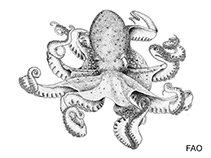Abdopus capricornicus (Norman & Flinn, 2001)
Uploaden van je Foto's
Google afbeelding | No image available for this species;
drawing shows typical species in Octopodidae.
Google afbeelding | No image available for this species;
drawing shows typical species in Octopodidae.
Classification / Names Common names | Synonyms | CoL | ITIS | WoRMS
Cephalopoda | Octopoda | Octopodidae | Octopodinae
Environment: milieu / climate zone / depth range / distribution range Ecologie
. Tropical
Verspreiding Landen | FAO regio's | Ecosystems | Voorkomen | Introducties
Western Central Pacific.
Length at first maturity / Size / Gewicht / Leeftijd
Maturity: Lm ? range ? - ? cm Max length : 4.2 cm ML mannelijk/geslacht niet bekend; (Ref. 96968); Maximaal gepubliceerd gewicht: 65.00 g (Ref. 96968)
Total length is 26 cm (Ref. 96968).
Life cycle and mating behavior Geslachtsrijpheid | Voortplanting | Kuitschieten | Eieren | Fecundity | Larven
Members of the class Cephalopoda are gonochoric. Male and female adults usually die shortly after spawning and brooding, respectively. Mating behavior: Males perform various displays to attract potential females for copulation. During copulation, male grasp the female and inserts the hectocotylus into the female's mantle cavity where fertilization usually occurs. Life cycle: Embryos hatch into planktonic stage and live for some time before they grow larger and take up a benthic existence as adults.
Voornaamste referentie
Referenties | Coördinator | Medewerkers
Wood, J.B. and C.L. Day. 1998. (Ref. 3722)
Status op de Rode Lijst van het IUCN (Ref. 130435: Version 2024-1)
Onvoldoende gegevens (DD) ; Date assessed: 21 July 2014
Status bij CITES (Ref. 108899)
Not Evaluated
CMS (Ref. 116361)
Not Evaluated
Gevaarlijk voor mensen
Gebruik door de mens
| FishSource |
Tools
Meer informatie
Trophic Ecology
voedselitems
Dieet
Voedselconsumptie
voedselhoeveelheid
Predators
Dieet
Voedselconsumptie
voedselhoeveelheid
Predators
Ecology
Population dynamics
Groei
Leeftijd/Grootte
Lengte-gewicht parameters
Lengte-lengte parameters
Lengtefrequenties
Mass conversion
recrutering
Abundantie
Leeftijd/Grootte
Lengte-gewicht parameters
Lengte-lengte parameters
Lengtefrequenties
Mass conversion
recrutering
Abundantie
Life cycle
Voortplanting
Geslachtsrijpheid
Fecundity
Kuitschieten
Eieren
Ontwikkeling van de eieren
Larven
Populatiedynamica van de larven
Geslachtsrijpheid
Fecundity
Kuitschieten
Eieren
Ontwikkeling van de eieren
Larven
Populatiedynamica van de larven
Distribution
Human Related
Aquacultuurprofiel
Stamps, Coins Misc.
Stamps, Coins Misc.
Outreach
Taxonomy
References
Internet-bronnen
BHL | BOLD Systems | CISTI | DiscoverLife | FAO(Publication : search) | Fishipedia | GenBank (genoom, nucleotide) | GloBI | Gomexsi | Google Books | Google Scholar | Google | PubMed | Tree of Life | Wikipedia (ga naar, zoek) | Zoological Record



